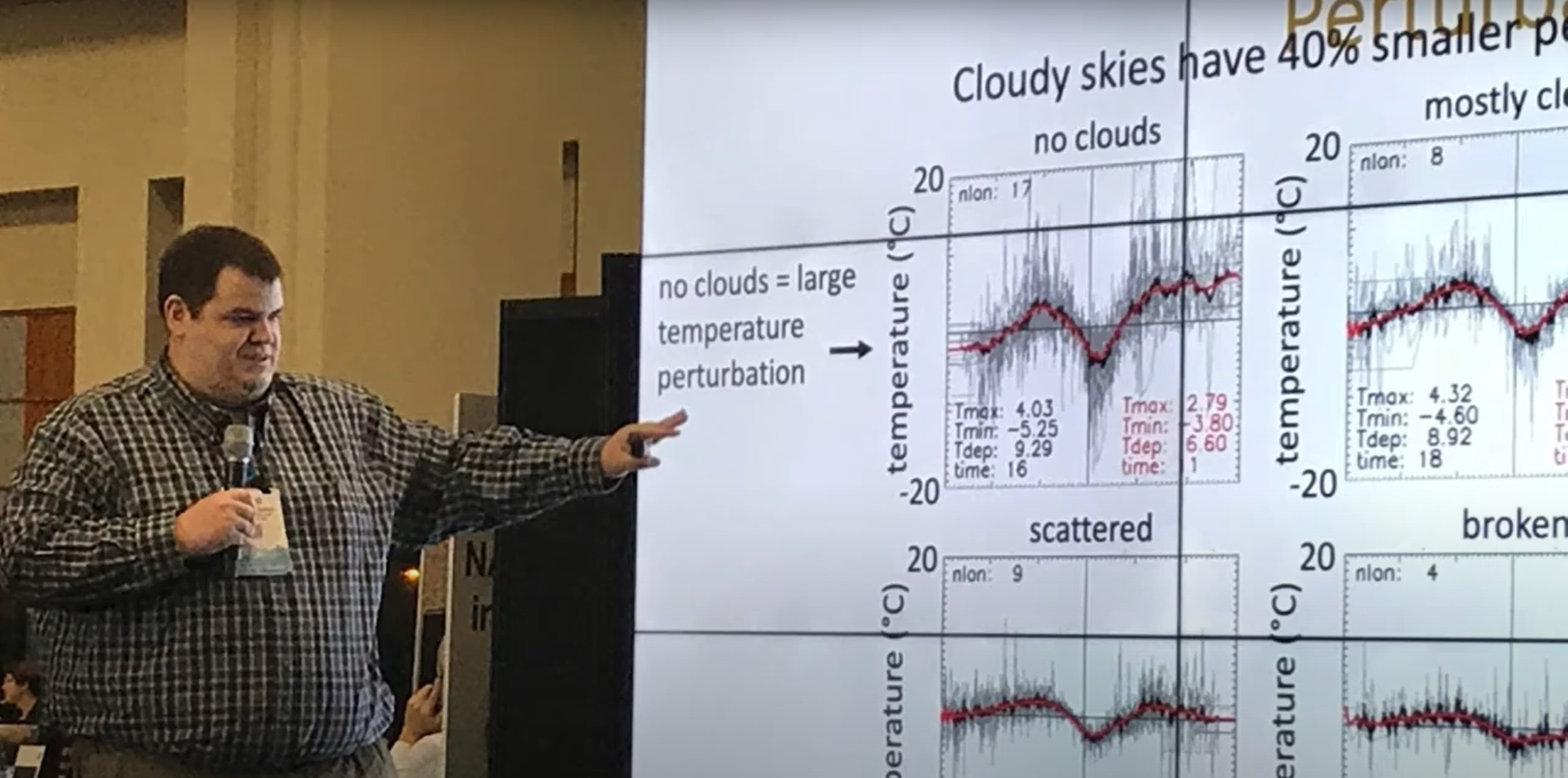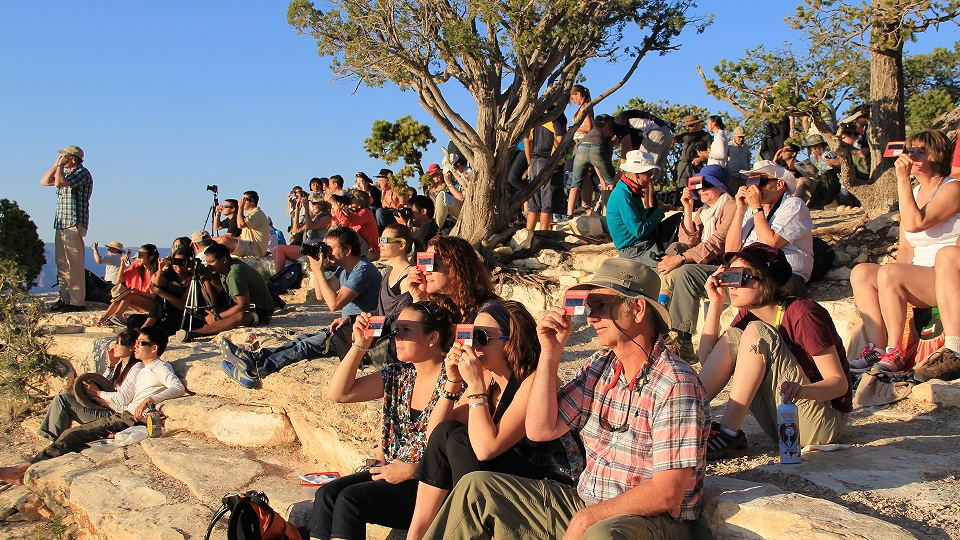News - GLOBE Observer
An Astronomical Atmospheric Experiment: A Backyard Astronomer's Guide to Experiencing a Solar Eclipse
The first eclipse I had the opportunity to witness was in July 1991. The path of totality passed through Mexico, but I was able to see the partial eclipse from Houston using a pinhole projector made from a cardboard box. I also saw an annular solar eclipse pass through the American Southwest in 2012. And most recently I witnessed 2017’s “Great American” total solar eclipse. In 2018, I was given an opportunity by the GLOBE Clouds team at NASA's Langley Research Center to research the meteorological effects of the 2017 eclipse using data collected by participating citizen scientists using The GLOBE Program’s GLOBE Observer app. In addition to the details of that particular research topic, I learned a great deal about the lengthy history of atmospheric scientists studying solar eclipses to learn more about Earth’s weather and climate.

This photo was taken during a presentation about solar eclipse meteorology I gave at the NASA booth at the American Geophysical Union (AGU) fall meeting in 2018. Both the talk and the paper showed the relationship between cloud cover and eclipse-induced temperature perturbations using GLOBE Clouds data collected during the 2017 eclipse. Credit: NASA/GLOBE
Solar eclipses are fascinating and important for atmospheric scientists because they can be considered a “natural experiment” which can be used to help us better understand weather and climate. Studying the atmosphere can be challenging because unlike other branches of science, namely physics and chemistry, we (generally) cannot conduct controlled experiments with the atmosphere. We can’t fit the whole Earth into a laboratory, instead, we have to utilize the opportunities that nature provides. During a solar eclipse, the Moon temporarily, and abruptly, blocks sunlight from reaching regions of Earth in the eclipse’s path, usually small regions of the Earth. You can think of this as an experiment in which nature turns off the Sun for a short time period. We can then examine the meteorological responses to the brief disruption in sunlight and compare them to what we predict from our scientific equations and numerical models. Then, this data can be used to help find ways to improve these models and determine where there are discrepancies with the observations. Scientists have long recognized the value of solar eclipses as natural experiments, and so have studied eclipses for well over a century! During this research, scientists have identified several meteorological responses to solar eclipses. We’ll discuss three of the most significant responses in this blog.

The 2017 Eclipse Umbra as viewed from space. Credit: NASA
Meteorological Response #1:
The first, and perhaps most obvious, is the decrease in temperature during a solar eclipse. The abrupt reduction in ground heating by the Sun translates into a temporary temperature reduction of a few degrees Fahrenheit, and this can be felt by those viewing the eclipse. The temperature effect is strongest along the path of totality, but is significant even hundreds of miles away from the path of totality. The cooling effect is strongest right next to the ground, and it is noticeably less strong just a few dozen meters above the ground. Interestingly, the amount of temperature decrease is not consistent for all eclipses, nor constant during one eclipse. A number of factors can influence the temperature perturbation at a given location, including the winds, cloud cover, nearby weather systems, proximity to large bodies of water, and the local terrain. Even a person standing in a grassy field versus a paved parking lot can experience noticeable differences!

Cumulus clouds captured by GLOBE participant on 2017-08-21 (the day of a total solar eclipse in North America).
Meteorological Response #2:
The second common effect of eclipses are changes to the clouds. Many eclipses have been noted to coincide with changes in cloud cover, with the most common effect being a temporary decrease in clouds. Not all cloud types are affected equally – the most commonly affected cloud types are cumulus clouds. These clouds are fueled by the heat and moisture rising from the ground during the day. When the eclipse reduces the warming of the ground by the Sun, cumulus clouds briefly lose their fuel source, and so they wither away. This does not always happen, though!
Meteorological Response #3:
The third common meteorological effect by an eclipse are changes to the wind. Changes in wind have long been associated with solar eclipses, and there have been many reports of a chilly “eclipse wind” that blows just before totality. In truth, the response of wind to eclipses is particularly complex, and extensive research has been devoted to understanding it. There can be a few different kinds of effects depending on the weather conditions. Sometimes the wind speed can decrease, or at least become less gusty, as the cooling surface decreases turbulence at low altitude. Other times, the wind can speed up or even change direction because of large-scale circulation responding to the eclipse. People living in hilly or mountainous areas might experience anomalous winds as the eclipse interacts with the terrain. The different effects of eclipses on wind makes detailed wind measurements critical to improving our understanding of eclipses.
You may notice that these three effects are not independent of
each other – in fact, there is a lot of overlap! The change in
temperature can affect how the clouds and winds change. But the amount
and types of clouds can also affect the change in temperature, which
also influences the change in winds. And the wind is usually connected
with the temperature and clouds. All of these overlapping effects can
make the total response of the weather to solar eclipses very
complicated and tricky to understand. For this reason, we scientists
need many measurements from many different sources of many different
eclipses so that we can better understand the big picture of eclipse meteorology.
And therefore to help us gather those measurements, we are asking you to observe an eclipse using the GLOBE Observer app. With it you can document clouds as the eclipse progresses, report the land cover and surface conditions at your observations site, and record changing air temperature with a simple meteorological thermometer. Your observations will help us better understand how an astronomical event like an eclipse affects different atmospheric processes.

A crowd uses handheld solar viewers and solar viewing glasses to safely view a solar eclipse. Credit: National Park Service
Beyond their scientific value, eclipses are some of the most spectacular natural phenomena that we can observe with our own senses. There really is no other way to truly experience a solar eclipse than to be there in person – photos and videos do not do eclipses justice! In my experience, you don’t just watch them, but you feel them too. As the eclipse progresses, the Sun loses its warmth, the sky dims, and shadows become sharper. You may experience some of the meteorological effects of the eclipse, especially the rapid drop in temperature. The people you are with will likely show a wide range of emotions, from excitement to wonder and awe. Animals respond to the eclipse as well, with some settling down as if it’s night time, while others like crickets and songbirds begin to sing. During totality, you may experience the “360° sunset” where the horizon is lit up in every direction while the sky overhead is dark. But the entirety of the personal experience is difficult to describe in words. To me, during totality of the 2017 eclipse, it seemed like some great cosmic being had taken a hole puncher and briefly poked the Sun out of the sky. It was a surreal feeling, but in the best possible way. If at all possible, it is absolutely well worth taking the time and resources to travel to the path of totality and see a total solar eclipse!
Editor’s Note:
On 14 October 2023, an annular eclipse will take place in North,
Central and South America. And on 08 April 2024 there will be a
total solar eclipse in North America. For more information on both
these upcoming eclipses and how to contribute citizen science data
using the GLOBE Observer app during an eclipse, please go to the Eclipse
page on the GLOBE Observer website.
About the Author:
J. Brant Dodson is a research scientist at NASA's Langley Research Center and ADNET Systems, Inc. Brant uses data collected by NASA to study various features in weather and climate, with a focus on clouds and their relationships with the environment. Recently he investigated the use of citizen science data collected by the GLOBE Clouds program for studying aspects of Earth atmosphere, including solar eclipse meteorology. Brant is also the president of the Skywatchers astronomy club at NASA Langley.
“I’ve had an interest in both weather and space since my preschool days; and growing up in Houston, Texas I had many opportunities to explore both. My appreciation for meteorology stemmed from countless summer days watching afternoon thunderstorms grow and bring cooling relief from the Texan heat. As I got older, my interest in space grew after a pivotal visit to the NASA Johnson Space Center. I eventually chose to pursue atmospheric science as my profession, but with such a deep interest in astronomy, I also became an amateur astronomer. Though these two topics have their own respective scientific communities,, there are several ways in which they overlap. And the phenomena of solar eclipses beautifully highlight the connection between Earth and space and bring these two interests together for me.”

The first picture is me in my house in early grade school with a toy SST plane. The second is me at a summer science camp at the University of North Texas in 1997.
Comments
View more GLOBE Observer news here.








